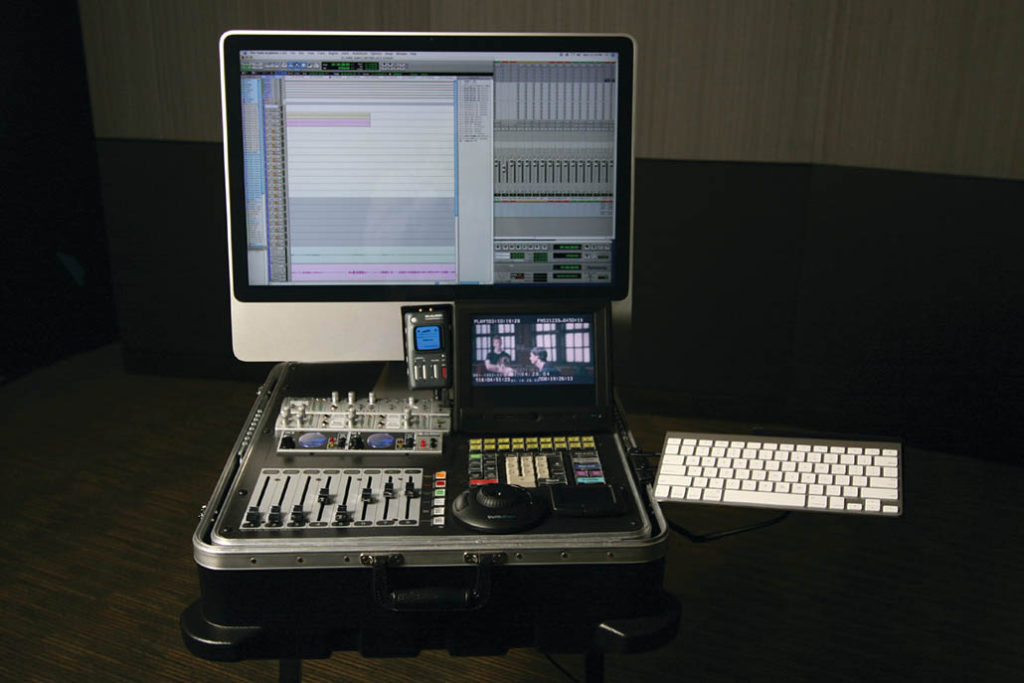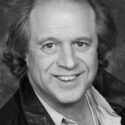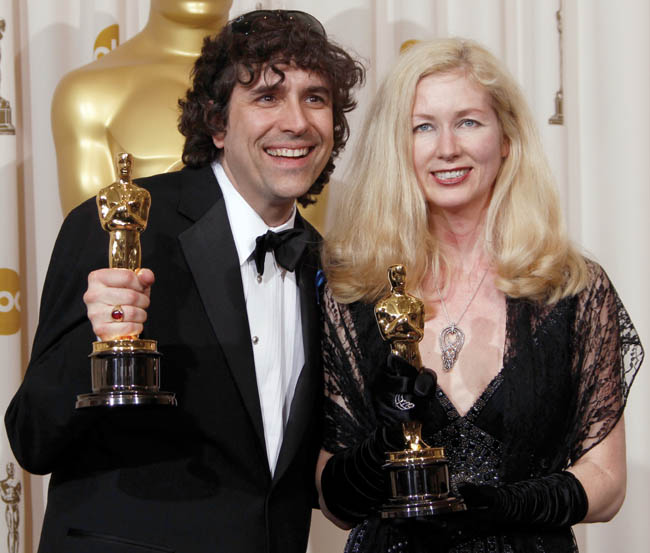
By Michael Kunkes
In today’s post production world, there is a time to shoot, and a time to loop. ADR dialogue looping is traditionally the realm of an ADR stage, usually located in a major production center, where actors re-record dialogue for scenes that were shot and edited weeks, sometimes even months after principal photography.
The “We’ll fix it in post” syndrome, of which ADR is a part, has few more ardent detractors than the production sound community. Today, there is a quiet, but growing movement to change the way things are being done. It’s not only the “when” of ADR that is being re-examined, but also the “how” and “where.”
Several factors are coming into play. Cooperation between production and sound has increased greatly over the past five or ten years. Producers, especially of blockbuster releases, are realizing that they can save tons of money by shooting at least some ADR during production, instead of sending crews our all over the world to catch up with actors, who have moved on to other projects.
Post supervisors, facing increasingly tight post schedules and budgets, are being asked to perform twice the work for half the cost. Also, the new generation of digital audio workstations, led by portable Pro-Tools rigs, is making ADR a moveable feast for actors and producers.
Breaking out of the confines of the ADR stage has historical precedent. In the days of the Hollywood studio system, contract players spent a portion of each workday looping dialogue; and in the 1950s, Cinemobile employed a moving van with 35mm projection and virgin loops. Then again, many lessons have come from television, where quick turnaround time made on-location ADR a necessity that continues to this day.
“The idea was to be able to ‘go to the talent’ for ADR, in their home, a hotel or just a convenient quiet place.” – Mark Gilbert
“In the 1970s, Gomillion Sound had a portable ADR truck that we used on CHiPs,” says Todd-AO sound editor Robert Deschaine, who helped pioneer on-set portable playback for looping on the two Babe features. “The actors and crew were out there on the freeway 12-14 hours a day, and you couldn’t get them back into the studio for looping. The trailer had a little insert booth to record the wild lines and motorcycle dialogue into 1/4 inch Nagra recorders. It was crude and noisy, and you had to make it very close, but it worked.”
Today’s mobile ADR trailer is designed to replicate all of the acoustical conditions of the best-equipped stage. At Cassady Studio Rentals, supervising sound editor Lee Dragu has designed a fully mobile ADR stage that has been used on TV series such as She Spies, C.S.I, The Handler and Las Vegas, and on features, including Basic and Win a Date with Tad Hamilton.
“The trailer is divided into two rooms: an engineer’s booth and a talent room.” Dragu says. “We engineered the trailer to keep external noise out, ensuring a clean recording, providing all of the controls you would have on stage.”
Dragu’s trailer is set up with a Do Re Mi V1 Hard Disk Video Recorder/Player, as well as ¾ inch video. “The picture is the master, and we use a TimeLine Microlynx keyboard system to sync. We can record directly to Pro Tools and/or DA-88 simultaneously, along with a DAT backup,” he explains, adding, “With TV, time is at premium, and it just makes sense to have post production on location.” Dragu says. “On She Spies, for example, there are three lead actresses who are in pretty much every shot. So, for one of them to disappear for half a day to do ADR can become a huge expense for the production.”

A similar setup, not on wheels, is employed by Martin Church, of Church Audio Post in Play Vista (CA). Church, who supervises ADR (along with ADR supervisor William Kerr) for both Jag and NCIS on a pair of adjacent stages in Santa Clarita (CA), runs ProTools through a Mac G4. “It’s a foolproof system,” Church relates. “We do all our principals and guest stars right there on a separate stage. The sheer logistics of getting people twenty miles down the hill to record ADR in LA made it necessary, and we’ve been shooting here for nearly 10 years.”
The height of portability has been reached at Skywalker Sound, where supervising sound editor Matthew Wood teamed with Mark Gilbert at the UK’s Gallery Software (creator of ADRStudio) to create a truly portable system that emulates a complete looping stage. It’s small enough to fit into a couple of small road cases in the back seat of a London taxicab. “I put the system together when I was working on Star wars: Episode 1, right at the time when the Powerbook became powerful enough to support a ProTools system,” Woods says.
“Matthew decided he was going to build a completely portable system, which could travel from place to place,” Gilbert related. “The idea was to be able to ‘go to the talent’ for ADR, in their home, a hotel or just a convenient quiet place. Virtually all the ADR on Episode 1 was recorded with the ADRStudio software-based portable rig, which arrived with Matthew and the rest of the crew and was set up wherever they were needed.
“In most cases, we set up a professional studio,” he explained. “However, for the final looping sessions, Lucasfilm asked if they could come to my house for three days to record ADR,” Gilbert said. “So, we cleared out a bedroom and set up an impromptu recording booth. It was actually pretty sophisticated by the time we were done. We fixed up some camcorders and made a video link between the recording area in the bedroom and the living room, which acted as our control room. All the equipment was set up in a couple of hours, and over the next three days, a procession of actors passed through to perform their ADR, including Ewan McGregor, Liam Neeson, Jack Lloyd and many of the other leading actors in the movie. We also recorded portable ADr sessions in Mexicoand the Bahamas.
No one is saying that mobile trailers and portable studios ever replace the ADR stage, at least not yet.
Later during blue screen reshoots on Episode II at Ealing Studios, Wood says he set up one of their sound stages and when the actors weren’t shooting, they’d be sent over to him for looping. “There were instances where we knew an actor was going to have to loop a scene due to noise from the effects. Because we were shooting on digital video, we could take a down-converted DV of the shoot, digitize that right into ProTools, look at it and then loop it almost as soon as we shot it.”
Wood Continued, “Not only did we save the production a ton of money, we were dealing with the scene right as it happened, So the actor still had it fresh in his mind. The sessions were an incredible success and really proved the point that you don’t need to rely on a million dollar fixed recording studio for ADR. Once it’s recorded into ProTools, the material can be sent over an encrypted FTP back to the studio, where it can be instantly edited, which saves all that studio looping time, something most directors and producers would love to hear.”
Rence Tondelli, ADR supervisor on The Passion of the Christ, employed a ProTools set up when she flew to the set in Rome during the feature’s final shoot days. “I had downloaded the movie into Quicktime on my laptop. Since almost no one in the principle cast spoke fluid Latin, they were ad-libbing these long scenes in Italian,” she related. “I sat down with them in the library of my hotel, along with Father Bill, the film’s Latin translator, and we phonetically recorded the voices to playback as scratch tracks right into ProTools. It was a valuable tool that I also used on the set of Austin Powers: Goldmember, where we had an incredibly short schedule and Mike (Myers) was constantly trying out new lines.”
But, most ADR veterans maintain that even advanced portable equipment cannot filter out background sound, and mobile ADR must still be done in a quiet location. “Two things are essential to creating good ADR,” says Dragu. “The actor must feel comfortable enough to deliver a good performance. This performance must be captured in such a way that it can be seamlessly blended with the production dialogue in the final mix, and free of the anomalies you might encounter by recording in a hotel room or someone’s home. As any re-recording mixer will tell you, you can always add EQ and various reverbs to a loop to make it sound natural, but you cannot remove reverb and EQ if they exist in the original recording”
“The bottom line is that it will never be possible to anticipate all your ADR needs in advance,” – Tom Feleischman
On Universal’s summer blockbuster, The Chronicles of Riddick, dialogue/ADR supervisor Hugh Waddell at Soundelux also had the unique experience of actually recording on the set during a series of massive reshoots, We did two location shoots, one in Vancouver and one in London, where Judi Dench was appearing in a play. David Twohy is a director who is very attuned to sound needs and doesn’t view ADR as a necessary evil. I told him that we were not going to be able to get some of these guys back for the temp mix and were running out of actor availability. As it is with many blockbusters, this was a production sound mixer’s nightmare,” explained Waddell.
“Because I was present to observe the situation, I was able to walk right out onto the set with the actors, who hadn’t even moved out of their positions, and actually run through entire scenes again, top to bottom. It was ADR in a wild line kind of situation. Perhaps even better, because they didn’t have to recreate a performance weeks or months later. They gave readings that had life and energy.”
Waddell continued, “The most difficult part of looping is that when a production ends. I have to spend the bulk of my time jetting off to different countries to get them into a studio. Sending lines over ISDN is great, but unless you are sitting next to an actor and telling him why he is doing this, it becomes a much tougher process. That’s why, if I have more than half a dozen lines to record with a major character, I’ll always fly to them. So, yes, if I could, I’d be on the set all of the time to do the looping. Frankly, I’d rather be home feeding my dogs.”
However, no one is saying that mobile trailers and portable studios ever replace the ADR stage, at least not yet. “The ADR stages and mixers in Los Angeles are top notch, and if I had my druthers, I would always go there first,” Tondelli states. “But, doing ADR on location seems to be happening more and more, especially if you are jammed and need to get something very quickly”
“Not only did we save the production a ton of money, we were dealing with the scene right as it happened, So the actor still had it fresh in his mind.” – Matthew Wood
New York based re-recording mixer Tom Feleischman notes that these are all valid points. “But, the bottom line is that it will never be possible to anticipate all your ADR needs in advance,” he said. “Things will always come up in post production that have nothing to do with the quality of the tracks. Anticipation and planning will always be key.”
“Location ADR is a growing trend,” says Waddell, “especially on movies produced out of country. In Hollywood, however, studios have a way of just going about business as usual. They just don’t look at sound as an integrated process. We must all press for more interaction between the post and the production world.”





